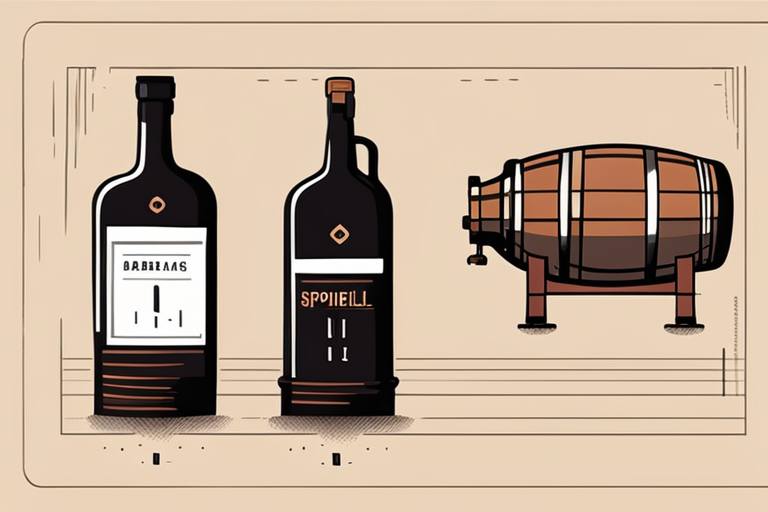
Signs of Spoilage in Barrel Aged Barleywine
Get Your Free Food Safety Cheat Sheet
30 most common foods with instant answers. Print it and stick it on your fridge—completely free!
Signs of Spoilage in Barrel Aged Barleywine
Barrel-aged barleywine is a delicacy for beer enthusiasts, cherished for its complex flavors and aging process. However, like any perishable food item, it is crucial to be aware of the signs of spoilage to ensure your enjoyment and safety. In this blog post, we will explore the key indicators that your barrel-aged barleywine may have spoiled and provide practical tips on how to store and preserve it properly.
Understanding Barrel Aged Barleywine
Before delving into the signs of spoilage, let's first understand what barrel-aged barleywine is. Barleywine is a strong ale known for its high alcohol content and rich, malty flavors. When aged in barrels, such as bourbon or wine barrels, the beer absorbs unique characteristics from the wood, adding depth and complexity to its taste profile. The aging process can range from several months to years, resulting in a nuanced and sought-after beverage.
Factors That Influence Spoilage
Several factors can contribute to the spoilage of barrel-aged barleywine, including:
- Temperature Fluctuations: Variations in temperature can impact the stability of the beer and lead to off-flavors.
- Light Exposure: Ultraviolet light can cause chemical reactions in the beer, leading to skunked flavors.
- Oxygen Infiltration: Excessive oxygen exposure can oxidize the beer, resulting in a stale or cardboard-like taste.
- Contamination: Introduction of harmful microorganisms can spoil the beer and pose health risks.
Signs of Spoilage
Recognizing the signs of spoilage in barrel-aged barleywine is essential for maintaining its quality and ensuring your safety. Here are the key indicators to watch out for:
1. Off-putting Aromas
Spoiled barleywine may emit unpleasant odors that are indicative of spoilage. These aromas can range from musty and moldy to sour and vinegar-like.
2. Unusual Appearance
Visually inspect the barleywine for any abnormalities, such as cloudiness, sedimentation, or unusual color changes. These visual cues can signal microbial contamination or oxidation.
3. Flavor Changes
Spoilage can manifest in the beer's taste profile, leading to off-flavors such as sourness, astringency, or off-putting bitterness. If the beer tastes markedly different from its intended flavor profile, it may have spoiled.
4. Carbonation Levels
Monitor the carbonation levels of the barleywine. Excessive carbonation or lack thereof can indicate fermentation issues or contamination.
5. Texture and Mouthfeel
Spoiled barleywine may exhibit inconsistencies in texture and mouthfeel, such as excessive thinness, oiliness, or slickness. These textural changes can be a sign of spoilage.
Storage and Preservation Tips
To prolong the shelf life of your barrel-aged barleywine and prevent spoilage, consider the following storage and preservation tips:
- Maintain Consistent Temperature: Store the barleywine in a cool, dark place away from temperature fluctuations to preserve its flavors.
- Minimize Light Exposure: Shield the beer from direct sunlight or artificial light sources to prevent light-struck flavors.
- Seal Properly: Ensure the bottle is tightly sealed to prevent oxygen infiltration and contamination.
- Store Upright: Store the bottle upright to minimize contact between the beer and the cork or cap, reducing the risk of oxidation.
- Monitor Conditions: Regularly inspect the barleywine for any signs of spoilage, such as off-odors or visual changes.
Conclusion
In conclusion, being able to identify the signs of spoilage in barrel-aged barleywine is crucial for maintaining its quality and ensuring a safe drinking experience. By understanding the factors that contribute to spoilage, monitoring the beer for key indicators, and following proper storage practices, you can enjoy your barrel-aged barleywine to the fullest. Remember to trust your senses and err on the side of caution if you suspect that your beer may have spoiled. Cheers to savoring the intricate flavors of barrel-aged barleywine responsibly!

Authoritative Food Safety References
These agencies and university labs inform every tip and health precaution we publish.
USDA FoodKeeper – Cold Storage Guidelines
Official refrigerator, freezer, and pantry timelines maintained by the U.S. Department of Agriculture.
Visit USDA FoodKeeperFDA Produce Safety Rule & Grower Guidance
Field-to-fridge handling practices that prevent contamination of fruits, vegetables, and leafy greens.
Visit FDA Produce SafetyCDC Foodborne Illness Prevention Hub
Surveillance-backed guidance on pathogens, symptoms, and steps to reduce foodborne illness risk.
Visit CDC Food SafetyUC Davis Postharvest Technology Center
University research detailing optimal storage atmospheres for produce after harvest.
Visit UC Davis PostharvestPenn State Extension – Home Food Preservation & Safety
Peer-reviewed extension bulletins on safe canning, chilling, and reheating practices.
Visit Penn State ExtensionHow can I tell if my barrel aged barleywine has spoiled?
Can barrel aged barleywine make me sick if it's spoiled?
How should I store barrel aged barleywine to prevent spoilage?
Can I still drink barrel aged barleywine if it's past its best before date?
How long does barrel aged barleywine typically last before spoiling?
Get Your Free Food Safety Cheat Sheet
30 most common foods with instant answers. Print it and stick it on your fridge—completely free! Want more? Upgrade to the complete guide with 70+ foods.
Scan your food directly and get instant safety info using our AI-powered camera feature.